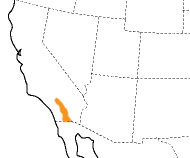Peninsular Leaf-toed Gecko
Scientific Name: Phyllodactylus nocticolus / Common Names: Peninsular Leaf-toed Gecko
|
The Peninsular Leaf-toed Gecko is the only nocturnal, climbing gecko native to the continental United States. The Leaf-toed Gecko’s distinctive swollen toepads only cover the tips of the toes, and have a bilobed shape unlike those of other geckos found in North America. This is a typical gecko with large head, flattened body, enlarged toepads, and immoveable eyelids. A small species, it reaches 2 - 3.3 in. (5-8.4 cm) TL. Scales on the back are finely granular, with scattered larger keeled tubercles. Peninsular Leaf-toed Geckos are translucent pinkish, brown or gray in color with irregular dark brown markings above, and pale beneath.
Habitat and Range The Peninsular Leaf-toed Gecko is found on semi-desert mountain slopes of southern California southward through most of the Baja California peninsula. They frequent the Lower Sonoran Life-zone, in areas of desert scrub and chaparral, and prefer canyons and areas with large areas of exposed rocks. They can be found near streams and springs, but also in more arid areas without permanent water. The Leaf-toed Geckos (Phyllodactylus) are a group of a dozen or more species distributed across the Americas. Habits Leaf-toed Geckos are excellent climbers, seldom found far from rocks. At night, they can be seen stalking insects and spiders across the surface of rocks and boulders. By day, they can be found under exfoliating slabs of granite or in crevices, and occasionally under loose bark of mesquite and other desert trees. As with all geckos, they lay clutches of 1-2 eggs usually stuck to the undersides of rock slabs or in crevices. The eggs are round and measure 0.25 in. (6 -7 mm). Leaf-toed Geckos will often squeak when caught, and readily lose their tails, which will regrow. Leaf-toed Geckos hibernate during the coldest months. Similar Species Banded Geckos (Coleonyx switaki, C. variegatus) lack toepads and have moveable eyelids. Granite and Desert Night Lizards (Xantusia sp.) also lack toepads and have heads covered with large symmetrical plate-like scales. The introduced Stump-toed Gecko (Gehyra mutilata), Mediterranean Gecko (Hemidactylus turcicus), and Common Wall Gecko (Tarentola mauritanica) lack the distinctive bilobed toepads of Leaf-toed Geckos, and their ranges do not overlap that of the Peninsular Leaf-toed Gecko. Conservation & Other Threats The Peninsular Leaf-toed Gecko does not have protected status. As southern California’s human population soars, suburban and exurban development may encroach on the Gecko’s habitat. In some areas of Central America, introduced Mediterranean Geckos have displaced Leaf-toed Gecko species, at least in areas around human habitation. If, in the future, the range of the introduced Mediterranean Gecko or Common Wall Gecko expands into the range of the Leaf-toed Gecko, a similar displacement could occur. Overzealous collectors sometimes scatter shelter rocks or break off rock slabs, degrading or destroying the gecko’s microhabitat. This species profile relies heavily on: Bauer et al 1997; Dixon 1969; Grismer 2002; and Stebbins 2003 |
Size:
Habitat:
Active During:
Diet:
Color/Pattern:
Location:
|







